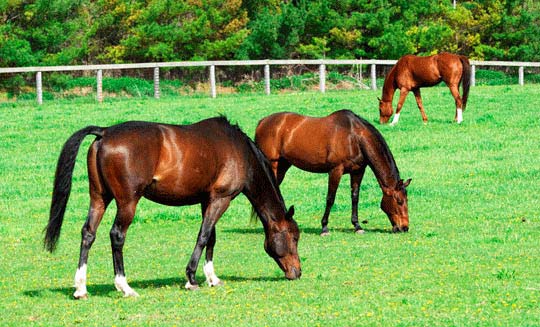 Whether your horses are located at home or on an agistment property you must plan and prepare for their safety.
Whether your horses are located at home or on an agistment property you must plan and prepare for their safety.
- Horses need a large open space to avoid bushfires
- Move your horses to a safer location before an Extreme or Catastrophic day
- Remove all gear, including rugs
- Seek treatment for burns quickly
Horses are quite good at avoiding bushfire if:
- They have enough room to move freely and get a good gallop up in a large open space
- There is minimal vegetation in the large open space
On Extreme or Catastrophic fire danger days, move your horses to a designated safer paddock or area. This may be:
- A large eaten out paddock
- A series of smaller eaten out paddocks with the internal gates left open
- A large sand ménage, provided there are no buildings or vegetation close-by that could catch fire.
Ideally the paddock should have a dam in it where the horse can seek relief from the heat.
Do not lock your horses in a stable, holding yard or similar environment. The horse may panic and hurt themselves if confined. The building may also catch on fire.
Do not let your horses out on the roads as they will be in more danger from traffic and fire.
A horse’s natural instinct is to run from danger including bushfire and they will quickly move to burnt ground to survive.
Ensure your property has a Property Identification Code (PIC) registered with Agriculture Victoria through the Department Jobs, Precincts and Regions (DJPR) that indicates horses are there. If your property is impacted by fire Agriculture Victoria may be able to enter after the fire to check on the welfare of your horses.
You may wish to move your horse to a property that is not in a high-risk area on days of Extreme or Catastrophic.
If your property isn't safe
Move your horses to a safer location before a fire starts. Once a fire has started, it is unlikely you will be able to safely move your horses to another location. Bushfires can travel quickly and roads will be dangerous, or possibly closed.
Develop your plan to temporarily move your horses on Extreme or Catastrophic days to:
- A neighbour or friend’s property that is better prepared than yours
- Local showgrounds
- Saleyards
- Racetracks
- Pony club grounds if they are better prepared than your own property
You will need to check that these places are open and willing to take horses prior to arriving. You may also be expected to stay with your horse in some places.
Arrange a group strategy with friends, other agistees or club members. If you agist your horses, find out what the bushfire plan is for the property.
Prepare your horses
On Extreme or Catastrophic fire danger days remove all gear, including rugs, from your horses. Some gear may melt or become very hot and cause serious burns, or get caught on fences. Also embers landing on rugs may cause the rug to catch on fire and the horse will not be able to get the rug off
Permanently identify your horses by microchipping or branding them. If your horse is difficult to catch, consider leaving a leather halter on with identification tags.
After the fire
- Check the paddock for trees and limbs likely to fall.
- Do not enter or have horses in paddocks with fallen power lines or damaged power poles.
- Some tree roots may burn underground creating extremely hot pits that could cause burns if stepped in.
- Getting horses off hot ground is important to prevent laminitis
- Check that their water is not contaminated and that they have food
- Check that fencing is safe
Horses tend to recover well after a fire. They may suffer facial burns and swollen eyelids. Seek appropriate treatment to restore them to full health quickly.
A horse suffering from burns requires prompt veterinary attention. Until the vet arrives, you can:
- Sponge affected areas with cold water
- If legs are affected, try standing your horse in a bucket of water
- Any first-aid administered should be anti-inflammatory.
Page last updated: Friday, 3 November 2023 10:34:53 AM